Relationship between Water Activity and Moisture Content in Floral Honey
Abstract
:1. Introduction
2. Materials and Methods
2.1. Materials
2.2. RH Meter
2.3. Aw Method
2.4. Literature Survey
2.5. Categorical Tests
2.5.1. Testing the Slope for Two Treatments
2.5.2. Testing the Slope for Three Treatments
2.5.3. Two Indicator Variables
3. Results
3.1. Water Activity of Honey
3.2. Comparison with Published Data
3.3. Effect of Honey Type on Aw
3.4. Effect of the Type and State of Honey on the Aw and MC Relationship
3.5. Comparison of the Correlation between Aw and MC with Two Datasets
3.5.1. Argentinian [7] and Slovenian Honeys [5]
3.5.2. German and Slovenian Honeys
3.5.3. Mixed-Source and Slovenian Honeys
3.5.4. Spanish and Slovenian Honeys
3.5.5. German (Crystallized State) and Slovenian (Liquid State) Honeys
3.5.6. Comparing the Correlation between Aw and MC with Three Datasets
3.5.7. Outlier Detection
4. Discussion
5. Conclusions
Funding
Acknowledgments
Conflicts of Interest
References
- Krell, R. Value-Added Products from Beekeeping; Food & Agriculture Organization of the United Nations: Rome, Italy, 2013. [Google Scholar]
- Grégrová, A.; Kružík, V.; Vrácovská, E.; Rajchl, A.; Čížková, H. Evaluation of factors affecting crystallization of disparate set of multi-flower honey samples. Agron. Res. 2015, 13, 1215–1226. [Google Scholar]
- Root, A.I.; Root, E.R. The ABC and Xyz of Bee Culture; Kessinger Publishing: Whitefish, MT, USA, 2010. [Google Scholar]
- Rockland, L.B. Water activity: Theory and applications to food. In IFT Basic Symposium Series; Springer: New York, NY, USA, 1987. [Google Scholar]
- Abramovic, H.; Jamnik, M.; Burkan, L.; Kač, M. Water activity and water content in Slovenian honeys. Food Control. 2008, 19, 1086–1090. [Google Scholar] [CrossRef]
- Cavia, M.M.; Fernández-Muiño, M.A.; Huidobro, J.F.; Sancho, M.T. Correlation between moisture and water activity of honeys harvested in different years. J. Food Sci. 2004, 69, 368–370. [Google Scholar] [CrossRef]
- Chirife, J.; Zamora, M.C.; Motto, A. The correlation between water activity and moisture in honey: Fundamental aspects and application to Argentine honeys. J. Food Eng. 2006, 72, 287–292. [Google Scholar] [CrossRef]
- Gleiter, R.A.; Horn, H.; Isengard, H.D. Influence of type and state of crystallisation on the water activity of honey. Food Chem. 2006, 96, 441–445. [Google Scholar] [CrossRef]
- Sanjuán, E.; Estupiñán, S.; Millán, R.; Castelo, M.; Penedo, J.C.; Cardona, A. Contribution to the quality evaluation and the water activity prediction of La Palma Island honey. J. Food Qual. 1997, 20, 225–234. [Google Scholar] [CrossRef]
- Zamora, M.C.; Chirife, J. Determination of water activity change due to crystallization in honeys from Argentina. Food Control 2006, 17, 59–64. [Google Scholar] [CrossRef]
- Zamora, M.C.; Chirife, J.; Roldan, D. On the nature of the relationship between water activity and % moisture in honey. Food Control 2006, 17, 642–647. [Google Scholar] [CrossRef]
- Beuchat, L.R. Influence of water activity on growth, metabolic activities and survival of yeasts and molds. J. Food Prot. 1983, 46, 135–141. [Google Scholar] [CrossRef]
- Beckh, G.; Wessel, P.; Lüllmann, C. Natü rliche best & teile des honigs: Hefen und deren stoffwechselprodukte—Teil 2: Der wassergehalt und die wasseraktivitä t als qualitätsparameter mit bezug zum hefewachstum. Deutsche Lebensmittel-Rundschau 2004, 100, 14–17. [Google Scholar]
- Ruegg, M.; Blanc, B. The water activity of honey and related sugar solutions. LWT-Food Sci. 1981, 14, 1–6. [Google Scholar]
- Alcalá, M.; Gómez, R. Cálculo, de la actividad de agua de la miel. Aliment Equip Technolo. 1990, 9, 99–100. [Google Scholar]
- Estupiñan, S.; Sanjuán, E.; Millán, R.; González-Cortes, M.A.; Cálculo, Y. Aplicación de modelos de predicción de actividad de agua en mieles artesanales. Microbial Aliments Nutr. 1998, 16, 259–264. [Google Scholar]
- Millán, R.; Tudela, L.; Estupiñán, S.; Castelo, M.; Sanjuán, E. Contribución al cálculo de la actividad de agua en miel: Modelo de predicción de actividad de agua en mieles de Las Palmas. Alimentaria 1995, 268, 77–79. [Google Scholar]
- Pérez, A.; Sánchez, V.; Baeza, R.; Zamora, M.C.; Chirife, J. Literature review on linear regression equations for relating water activity to moisture content in floral honeys: Development of a weighted average equation. Food Bioprocess Tech. 2009, 2, 437–440. [Google Scholar] [CrossRef]
- Salamanca, G.G.; Pérez, F.C.; Serra, B.J.A. Determinación de la Actividad de agua en mieles Colombianas de las zonas de Bocayá s Tolima. Apiservices—Galería Apícola Virtual. 2001. Available online: https://www.apiservices.biz/es/articulos/ordenar-por-popularidad/715-determinacion-de-la-actividad-de-agua-en-mieles-colombianos (accessed on 12 July 2018).
- Kutner, M.H.; Nachtheim, C.J.; Neter, J. Applied Linear Regression Models, 4th ed.; McGraw-Hill Education: New York, NY, USA, 2004; pp. 294–335. [Google Scholar]
- Myers, R.H. Classical and Modern Regression with Applications, 2nd ed.; Duxbury: Pacific Grove, CA, USA, 1998; pp. 135–153. [Google Scholar]
- Weisberg, S. Applied Linear Regression, 4th ed.; Wiley: New York, NY, USA, 2013. [Google Scholar]
- Chen, A.; Chen, H.; Chen, C. Use of temperature and humidity sensors to determine moisture content of Oolong tea. Sensors 2014, 14, 15593–15609. [Google Scholar] [CrossRef]
- Chen, H.; Chen, C. Equilibrium relative humidity method used to determine the sorption isotherm of autoclaved aerated concrete. Build Environ. 2014, 81, 427–435. [Google Scholar] [CrossRef]
- Chen, C. Sorption isotherms of sweet potato slices. Biosyst. Engin. 2002, 83, 85–95. [Google Scholar] [CrossRef]
- Chen, C. Moisture sorption isotherms of pea seeds. J. Food Eng. 2002, 58, 45–51. [Google Scholar] [CrossRef]
- Chen, C.; Weng, Y. Moisture Sorption isotherms of Oolong tea. Food Biopr. Technol. 2010, 3, 226–233. [Google Scholar] [CrossRef]
- Association Official Analytical Chemists. Official Methods of Analysis of AOAC International, 21th ed.; AOAC Scientific Publications: Arlington, VA, USA, 2019; Volume II. [Google Scholar]
- Bogdanov, S.; Martin, P.; Lullman, C. Harmonised methods of the European Honey Commission. Apidologie 1997, 1, 59. [Google Scholar]
- Cano, C.B.; Felsner, M.L.; Matos, J.R.; Bruns, R.E.; Whatanabe, H.M.; Almeida-Muradian, L.B. Comparison of methods for determining moisture content of citrus and eucalyptus Brazilian honeys by refractometry. J. Food Compost. Anal. 2001, 14, 101–109. [Google Scholar] [CrossRef]
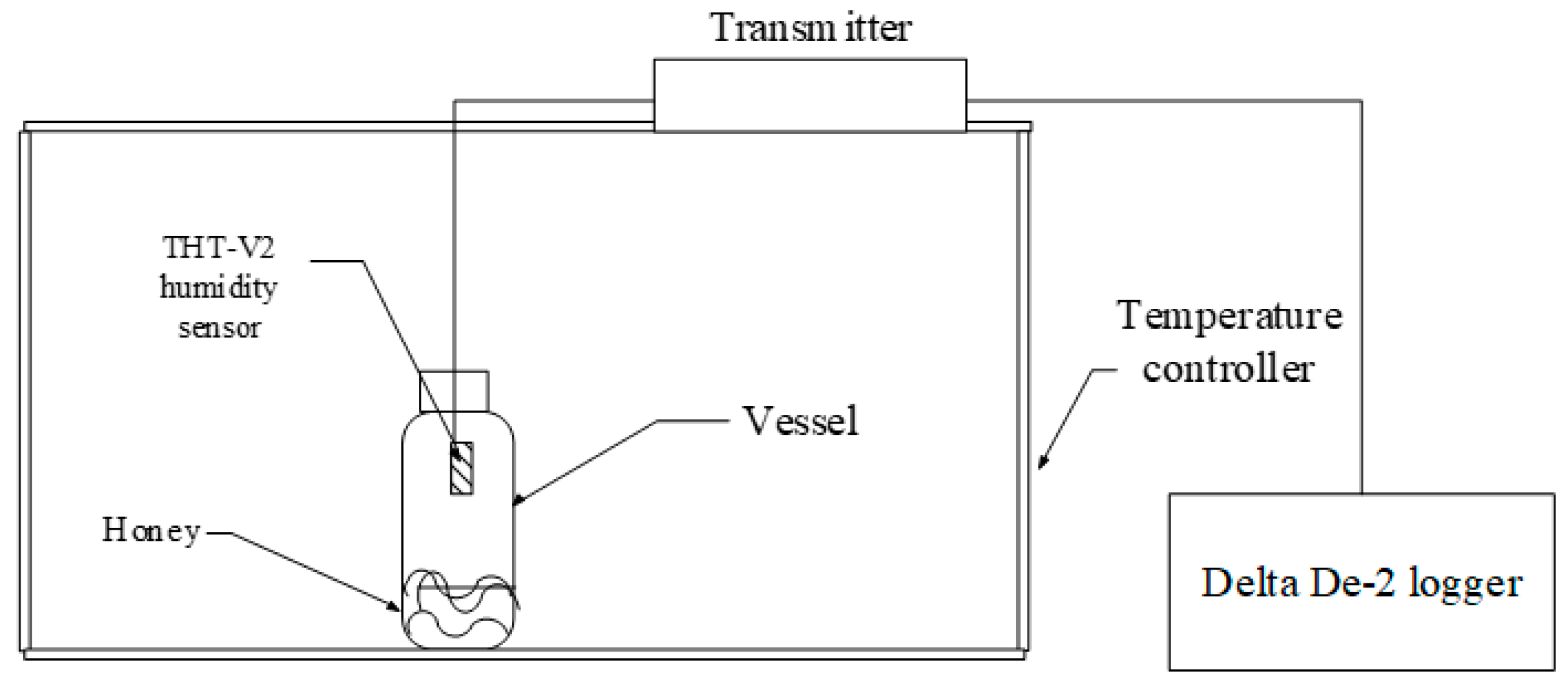
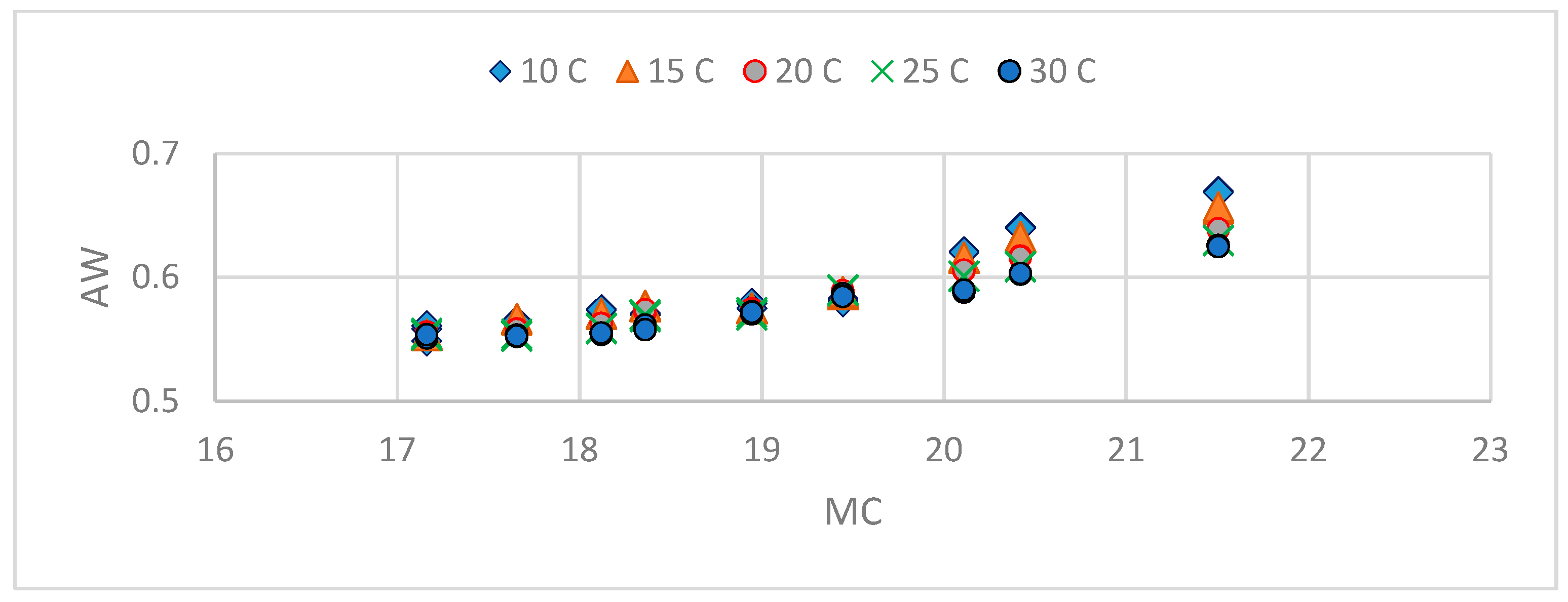
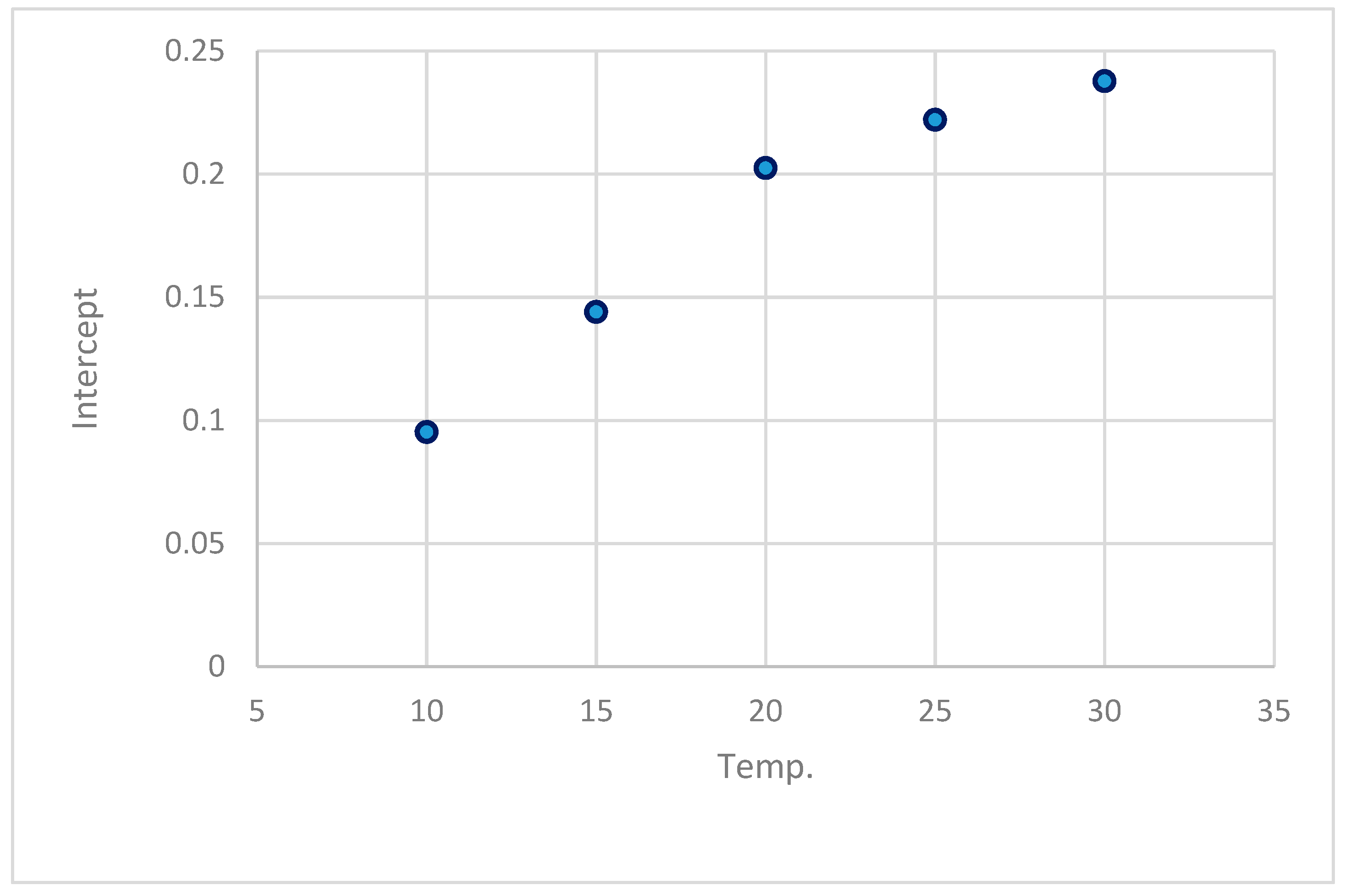

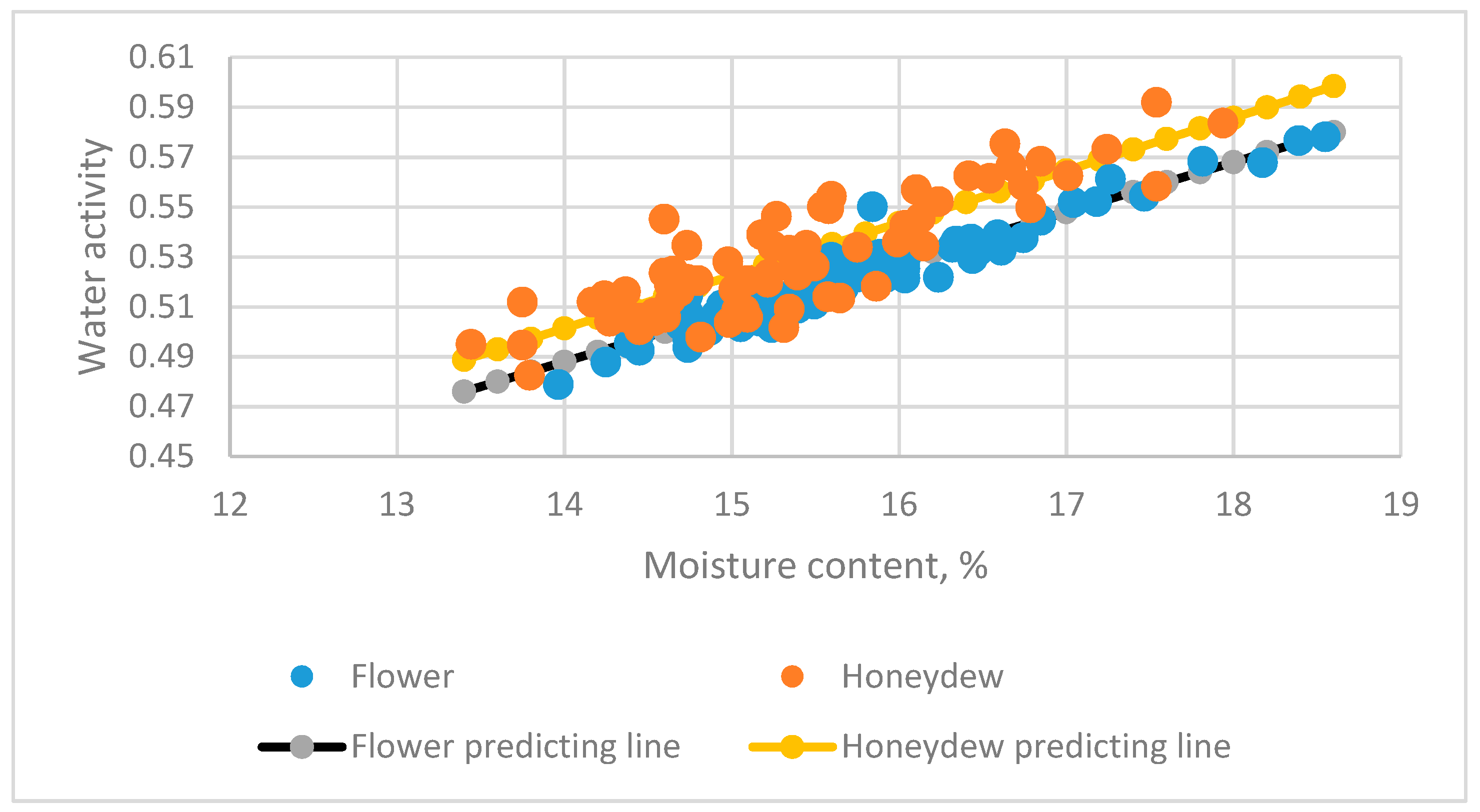

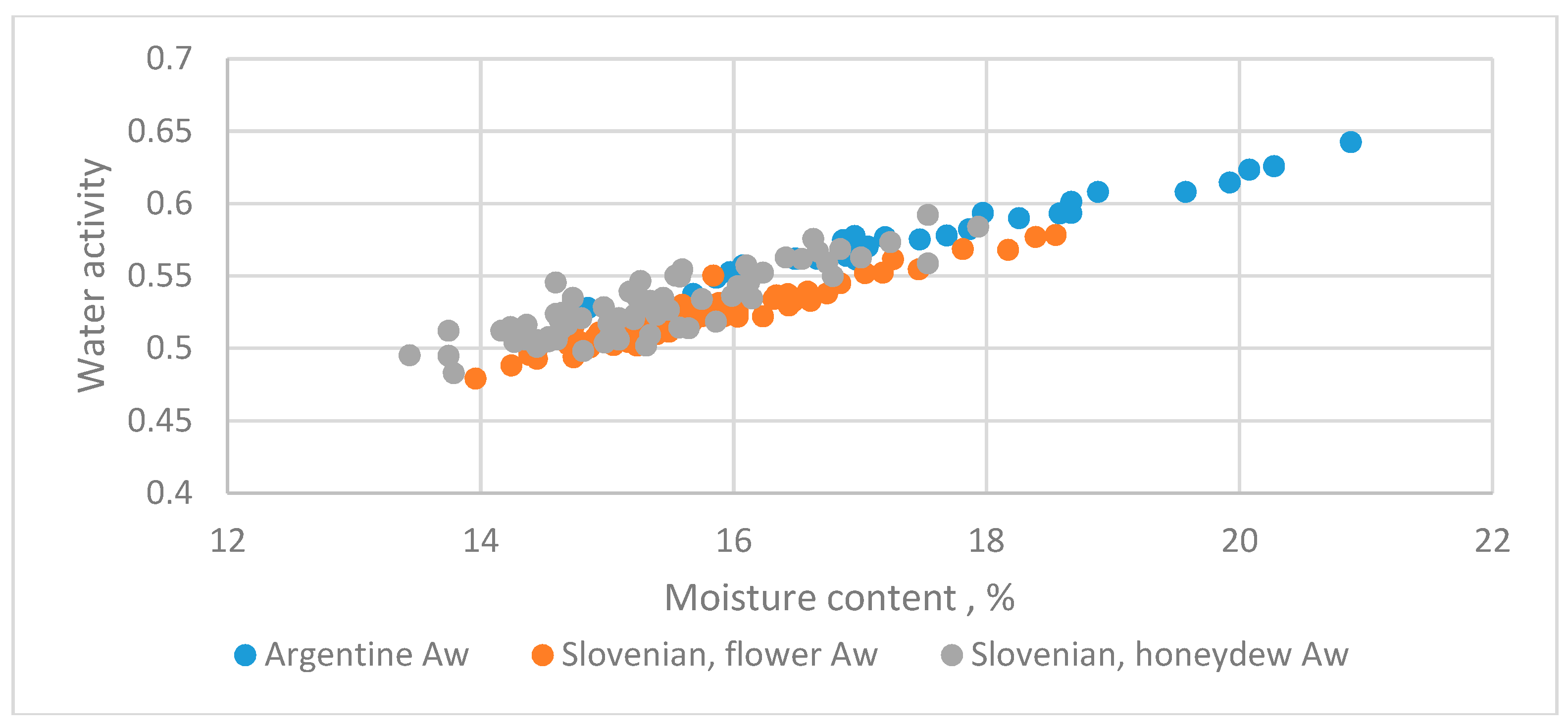

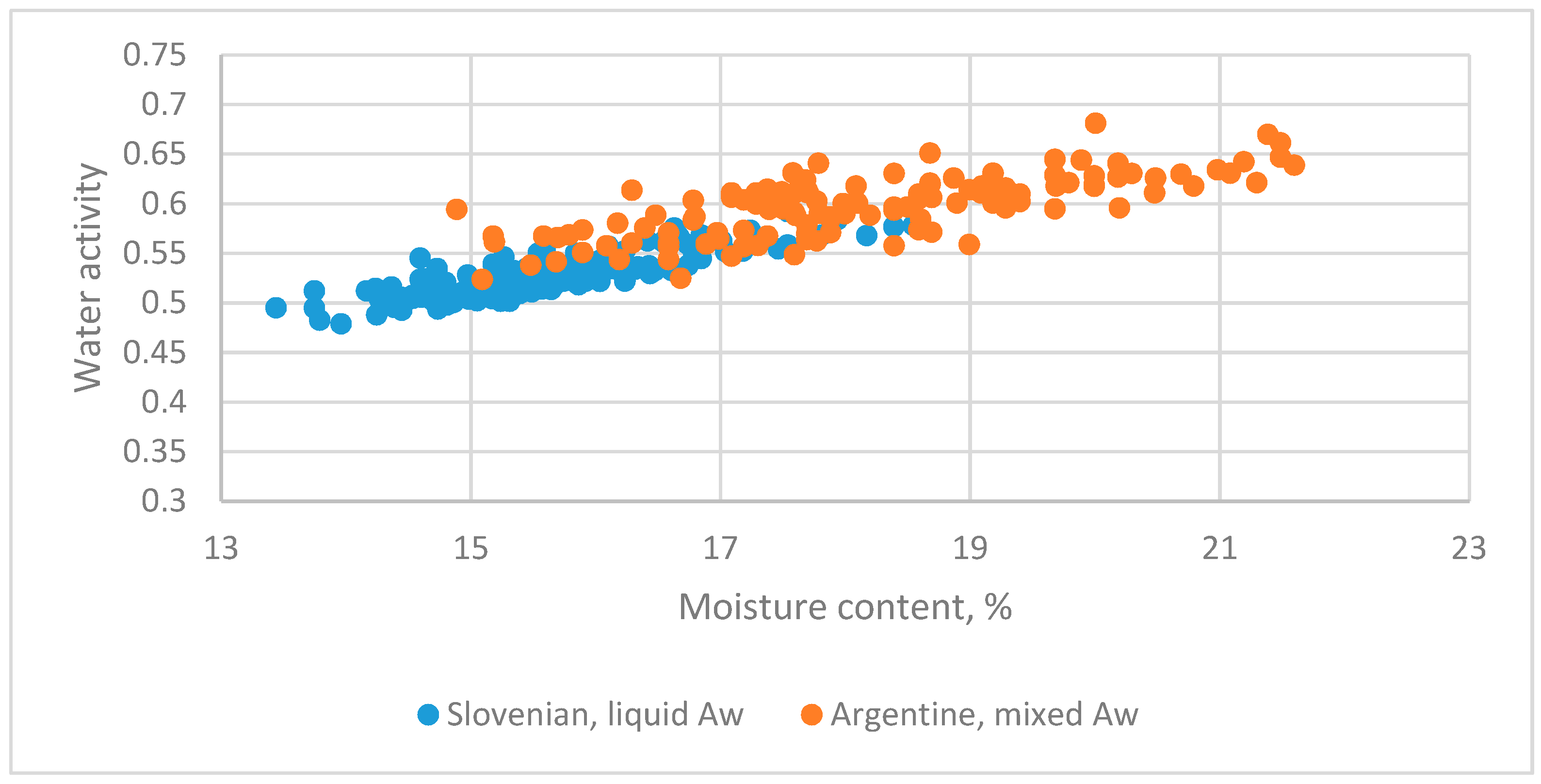
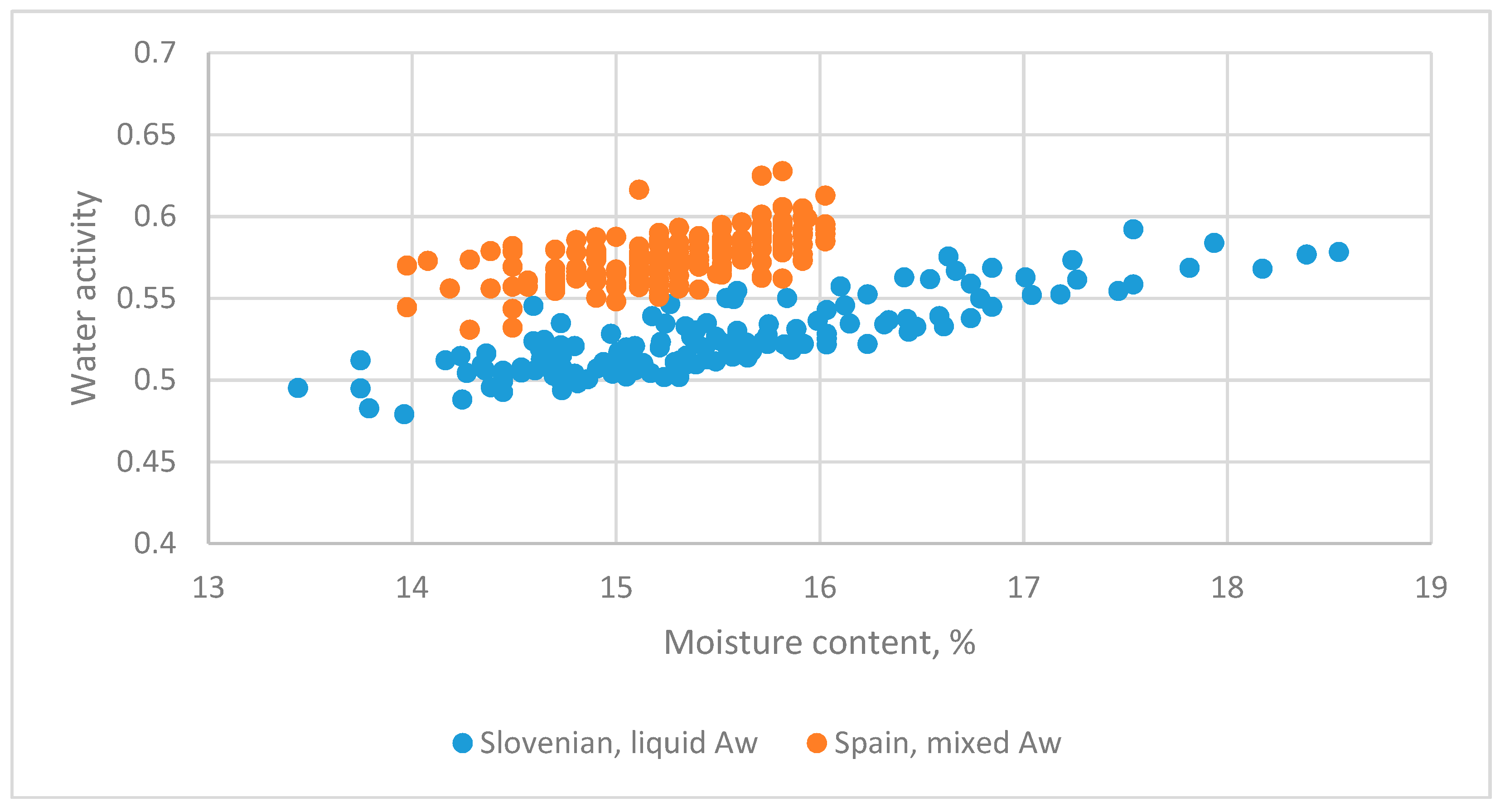
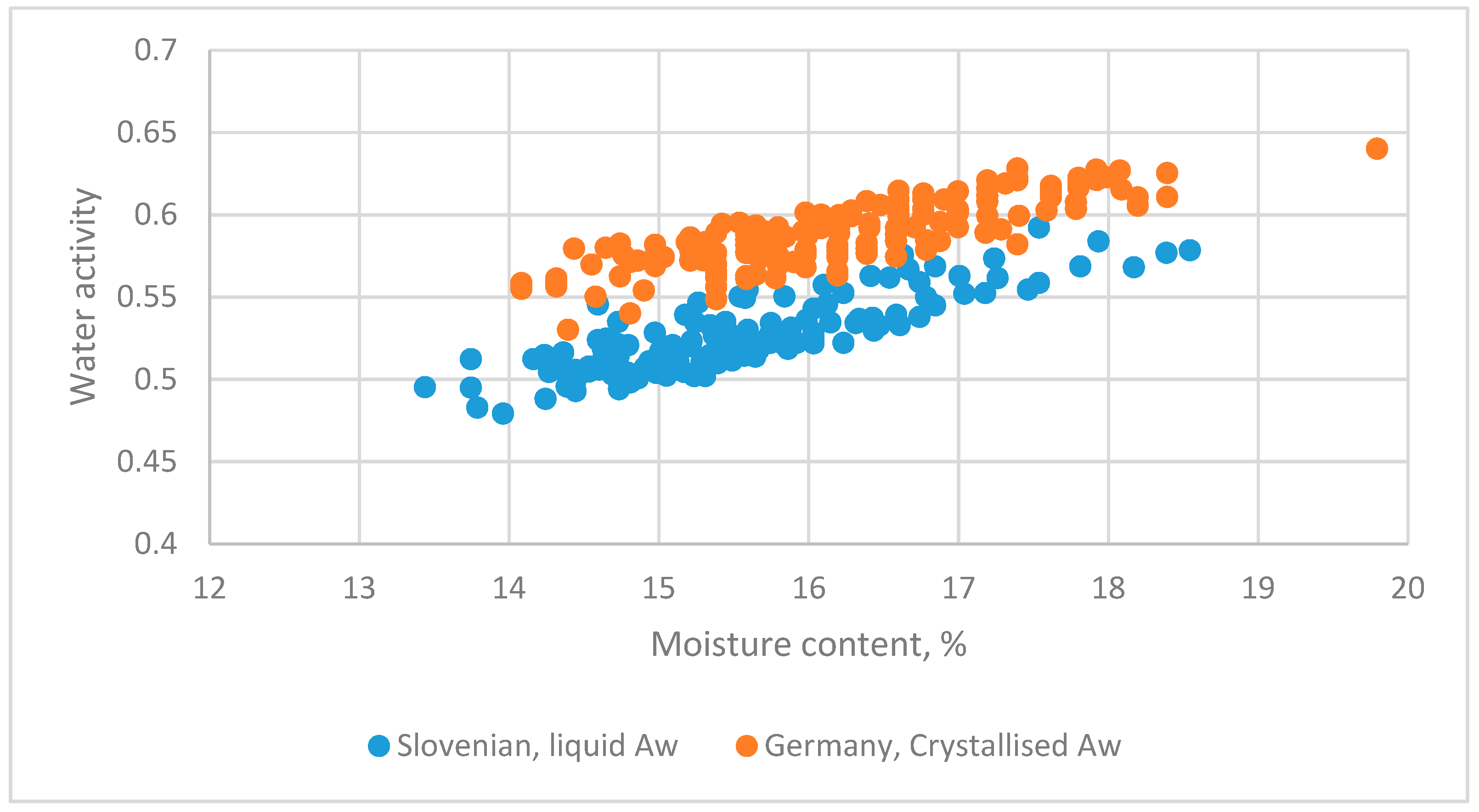
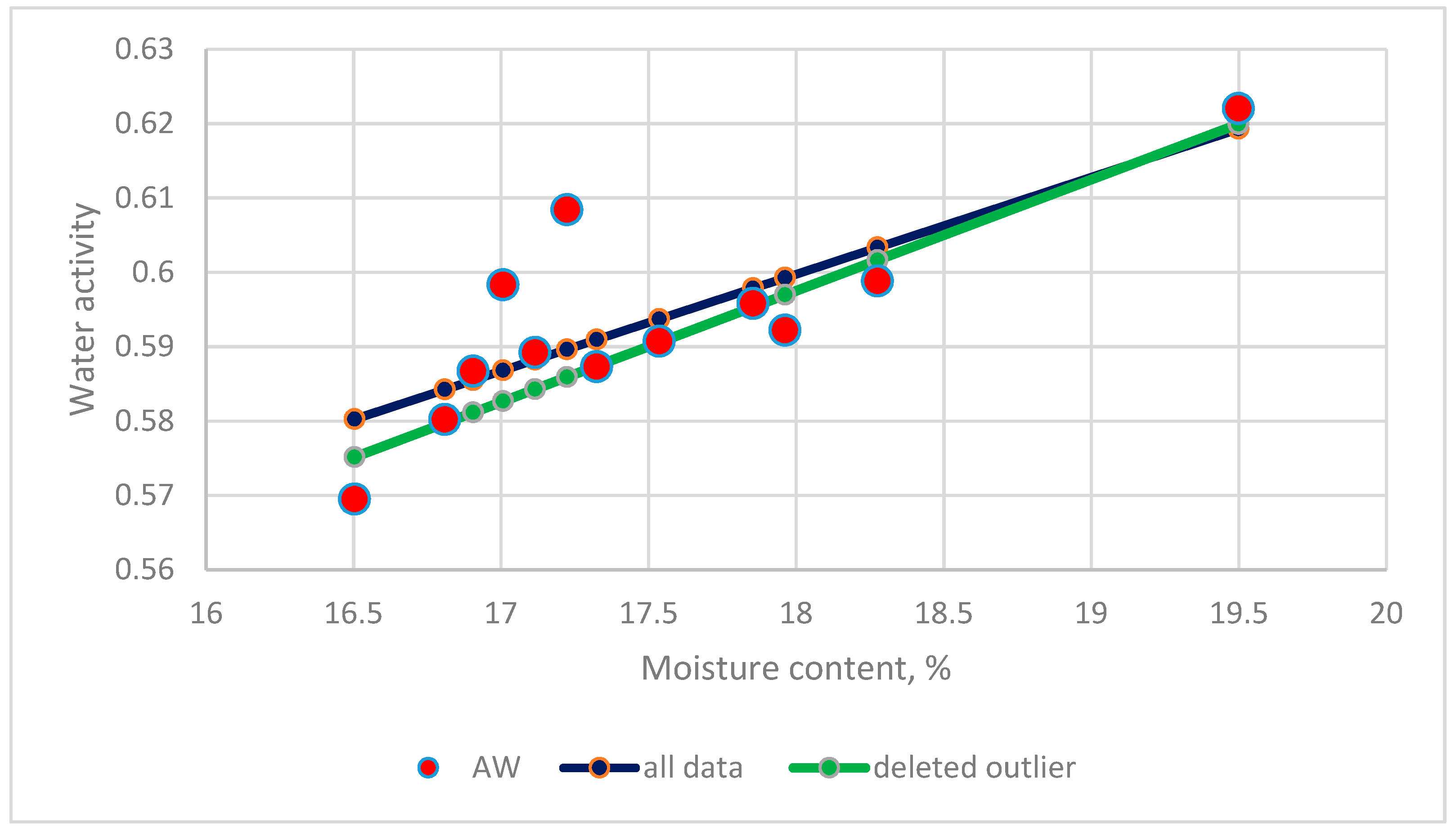
| Types | Geographical Original of Honeys | Aw Determination Method | Sample Size | Moisture Range (%) | Reference |
|---|---|---|---|---|---|
| Honeydew and flower | Slovenia | Cx-2T Chill-mirror Aw system | 150 | 13.4-18.6 | Abramovic et al. [5] |
| Flower | Spain (liquid and crystallized) | Cx-2T Chill-mirror Aw meter | 90 | 14.2-21.5 | Cavia et al. [6] |
| Flower | Argentine | Aqual series 3 Model TE dew-point Aw meter | 35 | 13.8-20.8 | Chirife et al. [7] |
| Honeydew and flower | Germany | Navasian Aw meter | 166 | 14.2-22.7 | Gleiter et al. [8] |
| Flower | Spain | Aqual series 3 Model TE dew-point Aw meter | 13 | 16.5~19.4 | Sanjuan et al. [9] |
| Flower | Argentine (liquid and crystallized) | Aqual series 3 Model TE dew-point Aw meter | 36 | 15.8~27.1 | Zamora et al. [11] |
| Study | Equations | Reference | |
|---|---|---|---|
| I. Datasets used in this study. | |||
| 1. | Aw = 0.23 + 0.019MC | (0.843) | Abramovic et al. [5] |
| 2. | Aw = 0.2674 + 0.01955MC | (0.709) | Cavia et al. [6] |
| 3. | Aw = 0.262 + 0.0179MC | 0.969 | Chirife et al. [7] |
| 4. | Aw = 0.35732 + 0.01349MC | 0.654 | Sanjuan et al. [9] |
| 5. | Aw = 0.305 + 0.0155MC | 0.969 | Zamora et al. [11] |
| II. Datasets not used in this study. | |||
| 1. | Aw = 0.13 + 0.025MC | (0.8230) | Alcala and Gomez [15] |
| 2. | Aw = 0.342 + 0.014MC | (0.723) | Beckh et al. [13] |
| 3. | Aw = 0.25643 + 0.01965MC | (0.813) | Estupinan et al. [16] |
| 4. | Aw = 0.38242 + 0.01211MC | (0.765) | Millan et al. [17] |
| 5. | Aw = 0.2686 + 0.01756MC | Meta-analysis | Perez et al. [18] |
| 6. | Aw = 0.0.271 + 0.0177MC | (0.901) | Ruegg and Blanc [14] |
| 7. | Aw = 0.248 + 0.0175MC | (0.973) | Salamanca et al. [19] |
| Temperature °C | Parameters | Standard of Deviations of Estimated Values s | ||
|---|---|---|---|---|
| A | B | |||
| 10 | 0.09520 | 0.026172 | 0.908 | 0.3195 |
| 15 | 0.14395 | 0.023511 | 0.936 | 0.2611 |
| 20 | 0.20243 | 0.020089 | 0.987 | 0.2165 |
| 25 | 0.22204 | 0.018839 | 0.968 | 0.1710 |
| 30 | 0.23771 | 0.017768 | 0.958 | 0.1536 |
© 2019 by the author. Licensee MDPI, Basel, Switzerland. This article is an open access article distributed under the terms and conditions of the Creative Commons Attribution (CC BY) license (http://creativecommons.org/licenses/by/4.0/).
Share and Cite
Chen, C. Relationship between Water Activity and Moisture Content in Floral Honey. Foods 2019, 8, 30. https://doi.org/10.3390/foods8010030
Chen C. Relationship between Water Activity and Moisture Content in Floral Honey. Foods. 2019; 8(1):30. https://doi.org/10.3390/foods8010030
Chicago/Turabian StyleChen, Chiachung. 2019. "Relationship between Water Activity and Moisture Content in Floral Honey" Foods 8, no. 1: 30. https://doi.org/10.3390/foods8010030






